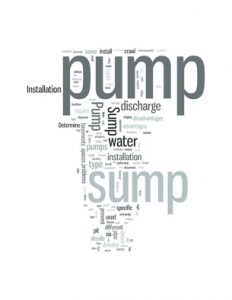
For those with basements, ie Northern Central Florida and north, this article is for you.
Every so often there is a whirring machine sound that comes on at random times, often in the middle of the night. One of those things that you never gave much thought to because you rarely heard it and if and when you did, you quickly forgot about it. On some days it is raining, sometimes there is not a cloud in sight. When was the last time you heard it? Maybe you last remember it was months ago while you were watching a movie, or walking out the door on a random Tuesday. Hidden away in the deepest corner of the basement, there is a battle being fought against water invasion. On the front line of defense is your sump pump. This often overlooked little machine prevents your basement from flooding by collecting ground absorbed water entering the building and flushing it out away from the home.
With a few simple steps and routine maintenance, you can throw worries to the side knowing that your residence is protected from the onslaught of water damage. A properly operating sump pump will tirelessly keep your home and belongings dry. A flooded basement is an expensive problem to fix, let alone what may get damaged from being soaked.
If your basement floods or is below the level of the sewer line, this is a necessary device to protect your home. It works by sitting below the level of the floor in a pit that allows the ground water moisture to collect in. Everything gets pumped out when water in the reservoir reaches a certain depth. A float operated switch powers up the machine. After the float drops back to the start position, the switch turns it back off to cycle again when the water rises to the trigger point. You can use either an above ground, pedestal type or a submersible model. Generally taking up less space, submersible pumps are most common and are prone to developing switch problems after several years of duty.
The sump pit is typically a painted metal or plastic sleeve that fits down into an 18 inch diameter hole about two and a half feet deep with several inches of gravel at the bottom. This is roughly equivalent to the size of a five gallon cylindrical bucket. Pit sleeves can be found at your local hardware store or home improvement center. An exit flow pipe, typically 1 ¼” plastic, will run up the wall to above ground level turning 90 ° to direct the water outside of the building as run off. To prevent backflow, a one way check valve should be installed.
Pro Tips:
Keeping a sump pump running smoothly throughout the rainy season is essential to avoid costly basement flooding. Clean and inspect the pump and its check valve at least twice a year. Examine the electric cord and plug, replacing them if needed. Check that the GFI wall socket is operating by pressing the test button and observing if the reset button pops out. As the vibrations over time may cause the gravel to settle or shift, ensure that the pump is sitting solidly on its base. Oil any serviceable parts, if required, according to the manufacturer’s instructions. Every three months or so, or if before leaving for a vacation, be sure to test the function of the pump. To simulate the conditions of actual use, simply take about two gallons of water and pour it down into the hole to see what happens. Your pump should spring into action, quickly sucking up the water and flushing it out and away through the exit pipe. If the pump is sluggish or makes noises, it may need to have the intake filters cleaned or replaced. Don’t forget go outside and check the exit drain. You need to be sure that there are no obstructions at the exit port and is sending the run off in the proper direction.